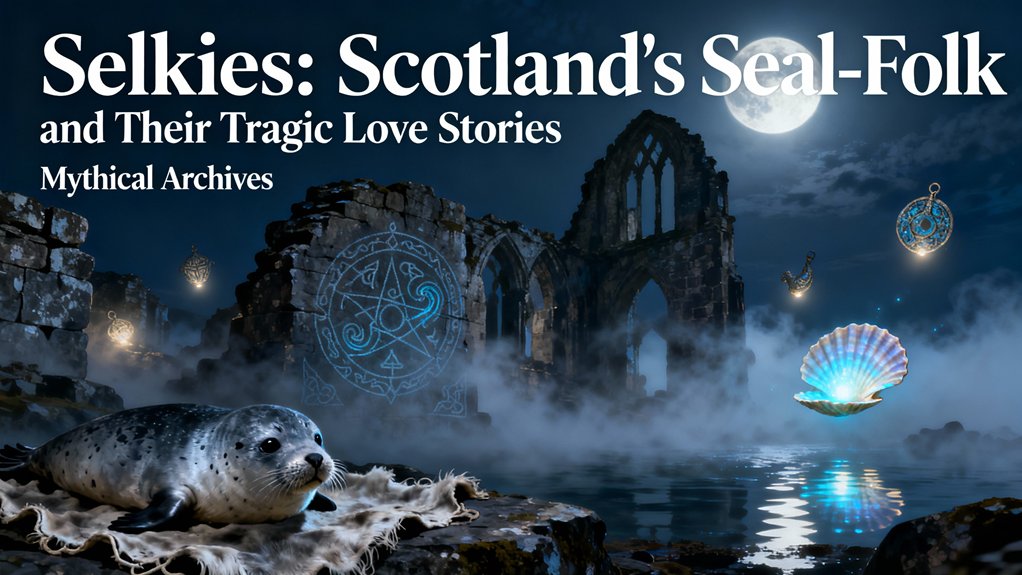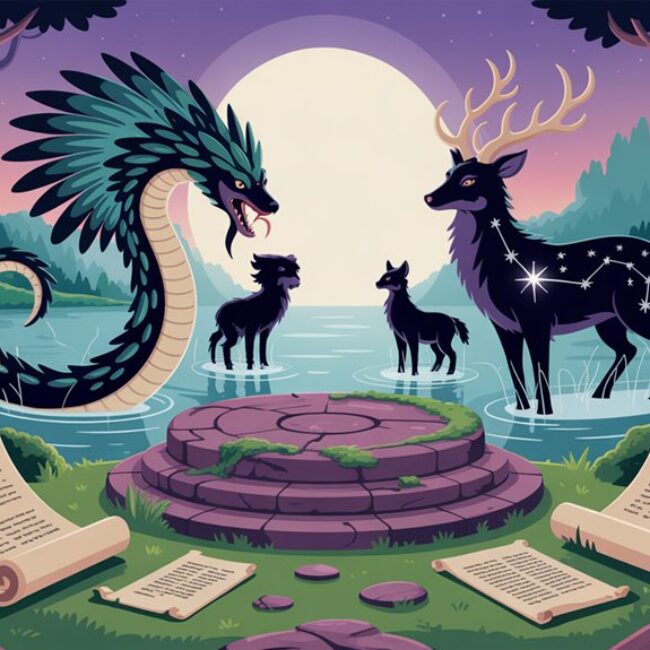You'll find selkies in Scotland's Celtic-Norse mythology—seal-folk who shed their pelts to become human, only to face captivity when fishermen steal and hide their skins, binding them to terrestrial marriages marked by profound melancholy. These narratives, densest in Orkney and Shetland since 800 CE, explore violation and fractured identity through half-human offspring bearing webbed fingers and oceanic longing. The tales, preserved in ballads like “The Great Silkie of Sule Skerry,” reveal fundamental truths about bodily autonomy, the corrosive nature of captivity disguised as love, and the impossibility of belonging to two worlds—themes that contemporary retellings continue to amplify and reinterpret.
Key Takeaways
- Selkies are mythological seal-people from Scottish folklore who can shed their sealskins to become human on land.
- Fishermen often capture selkie brides by stealing their sealskins, forcing them into marriages marked by melancholy and longing.
- Captive selkies eventually discover their hidden sealskins, often through their children, and return to the sea permanently.
- These tales explore themes of violation, captivity disguised as love, and the impossible duality of belonging nowhere completely.
- Originating from Celtic and Norse traditions, selkie stories remain culturally significant in Orkney, Shetland, and the Hebrides.
Origins of the Selkie Myth in Celtic and Norse Traditions
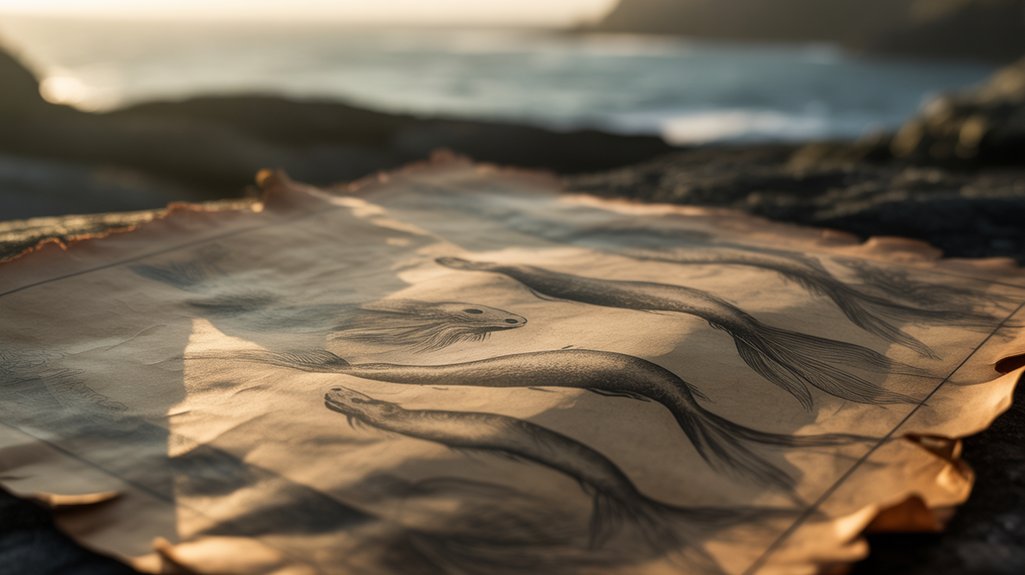
Where the grey Atlantic waters meet the jagged coastlines of Scotland's northern isles, the selkie legend emerges from a confluence of Celtic and Norse mythological streams, its origins as eldritch and multifaceted as the shapeshifters themselves.
You'll find the earliest traces in Celtic mythology, where seal-people inhabited the liminal zones between land and sea, embodying alteration's sacred power. The Norse folklore of the Orkney and Shetland settlers, arriving around 800 CE, brought their own shapeshifting traditions—the kopakonan and selchie of Scandinavian waters.
These traditions merged, creating something chimeric and uniquely Scottish. The isolation of these windswept archipelagos preserved these tales through centuries of oral transmission.
You're witnessing not mere superstition but ancestral wisdom encoded in narrative, born from communities whose survival depended on understanding the sea's mercurial nature. The selkie became their metaphor. Their truth.
The Geography of Selkie Legends: Orkney, Shetland, and the Hebrides
When you trace the selkie's eldritch presence across Scotland's northern archipelagos, you discover distinct geographical concentrations that mirror ancient maritime cultures.
The Orkney Islands harbor the densest repository of seal-folk narratives, their limestone coasts and tidal skerries forming a liminal threshold where alteration myths proliferated among Norse-Gaelic communities from the 9th century onward.
Shetland's windswept periphery and the Hebrides' Atlantic edge each nurtured their own chimeric traditions—the former preserving stark, melancholic accounts of seal-wives bound to land, the latter weaving Catholic and pre-Christian elements into tales of change that smell of salt spray and peat smoke.
Orkney's Abundant Selkie Tales
The Orkney archipelago harbors more selkie narratives per square mile than any other region in the Celtic world, its seventy islands serving as the epicenter of seal-folk mythology since at least the medieval period.
You'll discover Orkney folklore woven through every coastal settlement, each skerrie and tidal pool holding memories of change. The selkie symbolism here speaks directly to your desire for unbounded existence—these tales celebrate boundary-crossing, the refusal of fixed identity.
Fishermen's daughters who glimpsed seal-men emerging from moonlit waves. Stolen pelts hidden in stone bothies. Children born with webbed fingers, bearing witness to chimeric ancestry.
These aren't mere stories—they're territorial markers, psychological maps of an eldritch archipelago where transformation remains possible, where you might still shed constraining skins and dive deep.
Shetland's Coastal Folklore Traditions
North of Orkney by forty miles of Atlantic temperament, Shetland emerges from the sea with different selkie grammar—harsher, more Norse-inflected, its seal-folk tales bearing the unmistakable stamp of Scandinavian occupation that lasted from 875 CE until Scotland's 1469 annexation.
You'll find these Shetland legends shaped by Viking sensibilities: seal-wives who change beneath northern lights, selkies summoned through ritual sacrifice rather than mere longing. The coastal myths here pulse with eldritch power you won't encounter elsewhere.
These islands taught their inhabitants that freedom exists only in alteration. The seal-folk of Shetland embody chimeric sovereignty—neither wholly bound to land nor sea, they inhabit that liminal shore where ancient Norse cosmology merged with Celtic mysticism.
Here, the selkie represents ultimate autonomy: the ability to shed one's skin, abandon terrestrial constraints, return to oceanic wildness whenever domesticity suffocates.
Hebridean Seal-Woman Narratives
While Shetland's selkies bear Norse severity and Orkney's seal-folk navigate between worlds with quiet melancholy, the Hebrides—that scattered archipelago stretching along Scotland's western edge like vertebrae of some ancient sea-creature—harbor seal-woman narratives of devastating intimacy.
Here, Hebridean folklore doesn't merely whisper of alteration; it screams of violation, of stolen pelts hidden in thatch and stone. The seal woman lore of these islands pulses with domestic entrapment.
You'll find her gazing westward from cottage doors, seven children clutching her skirts, while her sealskin burns in some husband's locked chest. These aren't tales of voluntary metamorphosis. They're chronicles of captivity, of eldritch beings shackled to terrestrial existence, waiting—sometimes decades—for the moment liberation becomes possible again.
The Stolen Skin: When Fishermen Capture Selkie Brides
The most prevalent selkie narrative follows a stark, haunting pattern: a fisherman discovers the shed sealskin upon some moonlit shore, conceals it within thatch or locked kist, and thereby binds its otherworldly owner to terrestrial existence as his wife.
These marriages, documented throughout Orcadian and Shetlandic oral traditions since the sixteenth century, persist for years—sometimes decades—marked by the selkie-woman's melancholic yearning, her eldritch gaze forever drifting seaward.
You'll find the denouement proves inevitable: children inadvertently reveal the hidden skin's location, or the woman's relentless searching bears fruit, and she abandons hearth, husband, offspring to reclaim her maritime form.
Discovery of the Skin
Across countless moorland cottages and salt-weathered crofts, Scottish storytellers preserved a haunting narrative pattern: the discovery of an unattended sealskin along the shore, gleaming and supple beneath moonlight, still warm from its wearer's body.
This pivotal skin discovery moment represents humanity's intrusion into otherworldly domains—a violation of liminal boundaries. You'll find fishermen stumbling upon these pelts during selkie alteration, that vulnerable interval when seal-women shed their chimeric nature to dance upon sand.
The eldritch skin pulses with marine essence, silvered and iridescent, abandoned near tidal pools or tucked beneath coastal rocks. Here lies forbidden knowledge: possession grants control.
The man who seizes this pelt imprisons the selkie's authentic self, her oceanic freedom, her sovereignty. One theft. Eternal consequence.
Years of Captive Marriage
Once the fisherman conceals that stolen pelt—buried beneath hearthstones, locked within iron-bound chests, hidden in thatched roofing's secret hollows—the selkie woman becomes terrestrial prisoner, bound by sympathetic magic to shore and captor.
These tragic unions manifest across Scotland's coastal communities, generations of captive love documented in kirk records and genealogies. You'll find the pattern repeating:
| The Captor's Domain | The Selkie's Reality |
|---|---|
| Warm hearth, human children | Eldritch longing, oceanic dreams |
| Domestic contentment claimed | Silent mourning performed |
| Legal marriage recognized | Chimeric existence endured |
| Years accumulated | Soul fragmenting daily |
She bears children—half-human, half-seal—while scanning horizons. Her eyes hold depths no terrestrial love penetrates.
The marriage functions. It doesn't flourish.
She remains, but she's never truly arrived.
The Inevitable Return Home
When children discover the hidden sealskin—while searching for lost toys beneath floorboards, while exploring forgotten storage spaces during long northern winters, while their father travels to distant markets—the inevitable constellation of recognition aligns.
You'll witness alteration in their mother's eyes: that eldritch knowing that transcends human language. The inevitable longing, suppressed through years of terrestrial captivity, resurfaces with tidal force. She reclaims her chimeric nature, wrapping the salt-stiffened pelt around trembling shoulders.
Her sea connection, never severed despite landlocked years, pulls her toward breaking waves. The children watch from shore as she disappears beneath foam-crested swells.
Sometimes she returns, briefly surfacing near rocks where her half-human offspring wait, bringing fish, bringing impossible love. But she never stays.
Children Between Two Worlds: Half-Selkie Offspring in Folklore
The children born from these unions between selkie and human existed as liminal beings—neither fully of the sea nor entirely of the land, bearing within their blood the ancient duality of two incompatible worlds.
You'll find in Scottish oral traditions that these half-selkie offspring carried distinctive markers: webbed fingers or toes, unusually lustrous eyes that reflected moonlight like seal pups, an inexplicable affinity for tidal rhythms. Their half selkie identity created profound displacement—too strange for village acceptance, too human for the waves.
Physical and psychological manifestations included:
- Eldritch swimming abilities that surpassed mortal capacity, allowing them to hold breath for impossible durations
- Chimeric emotional states oscillating between terrestrial attachment and overwhelming oceanic longing
- Second sight granting prophetic visions of shipwrecks, storms, drownings
Cultural integration remained perpetually incomplete.
These children embodied freedom's cruelest paradox: belonging nowhere, called everywhere. They wandered shorelines at equinox, caught between inheritance and exile.
The Hidden Pelt: Tales of Discovery and Abandonment
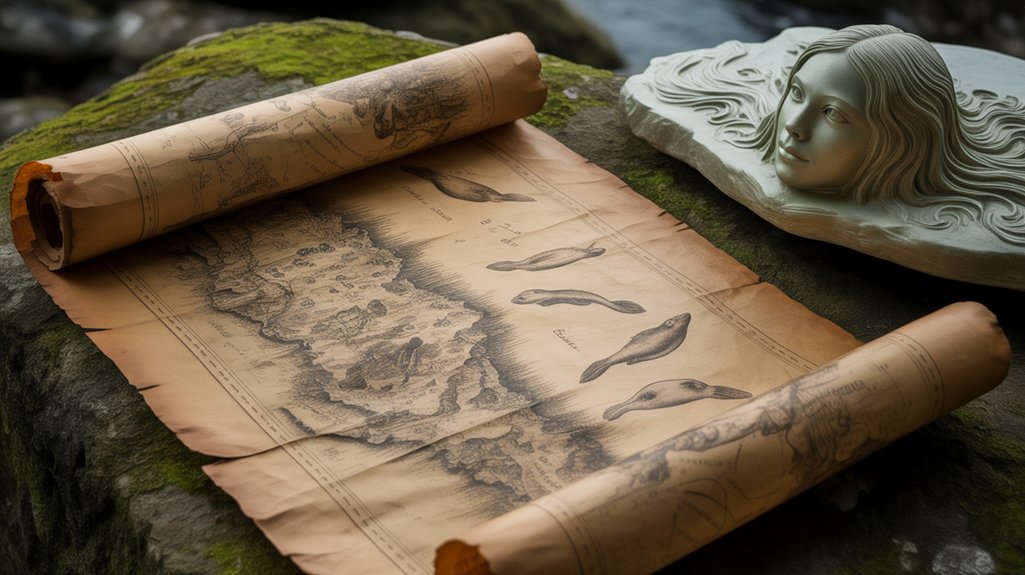
The most pervasive selkie narrative across Scottish coastal communities—documented from the Shetlands to the Hebrides since the sixteenth century—centers upon a fisherman's discovery of the hidden sealskin, that eldritch talisman binding the selkie to terrestrial existence.
You witness in these tales an unsettling pattern: the man conceals the pelt in rafters, stone cairns, locked kists, altering voluntary communion into captivity, the selkie woman becoming wife and mother whilst her oceanic nature withers beneath human constraints.
Yet the skin, possessing its own chimeric agency, inevitably reveals itself—found by curious children, uncovered during spring cleaning, whispered about by the wind—and the selkie, clutching that salt-stained membrane, abandons hearth and offspring for the cold absolution of the sea.
Finding the Seal Skin
How does one stumble upon a seal skin, tucked away in cottage rafters or buried beneath hearthstones, and what catastrophic chain of events does such discovery inevitably set in motion?
The finding occurs through accident—a cleaning woman's hand brushing forgotten corners, children playing where they shouldn't. These hidden treasures carry eldritch weight.
The moment of discovery typically unfolds through:
- Children investigating forbidden spaces during their parents' absence
- Servants conducting spring cleaning in previously untouched dwelling areas
- Storms forcing families to search for roof leaks in attic spaces
Once touched, the seal skin pulses with chimeric memory. The selkie wife freezes, recognition flooding her terrestrial form.
She'll abandon husband, children, hearth—everything human dissolves before that oceanic imperative. The pelt commands absolute sovereignty over constructed domesticity.
Forced Marriage and Captivity
Before any discovery demands reckoning, before children's hands brush dusty rafters, the captivity begins—that primal theft when fishermen claim what the sea never intended to surrender. This forced union operates through ancient coercion: hide the pelt, bind the selkie. Emotional captivity follows.
| Phase | Captor's Action | Selkie's State |
|---|---|---|
| Theft | Conceals sealskin in thatch, barn, kirk | Landlocked, powerless |
| Binding | Performs marriage rites | Chimeric existence begins |
| Domestication | Provides human children, household duties | Yearning intensifies |
| Dissolution | Skin discovered after seven years | Flight to eldritch waters |
You'll recognize these patterns across Hebridean testimony, Orkney ballads, Shetland crofter accounts—documented since the sixteenth century. The imprisoned selkie walks shorelines at gloaming, salt-sick, landlocked. Freedom remains always tantalizingly visible yet impossibly distant.
The Inevitable Return Home
When children's fingers probe the darkness between roof-beams—or when spring cleaning demands attention to neglected corners, or when storms tear thatch from cottage roofs—the concealed skin resurfaces, salt-crusted and waiting.
The inevitable longing, dormant yet undiminished, rises like spring tide. No human love, however genuine, can suppress the eldritch pull of ancestral waters.
The moment of discovery reveals:
- Children presenting the strange, briny pelt as curious treasure
- Wives uncovering hidden skins during mundane household tasks
- Storm winds exposing what husbands believed permanently secured
She takes the sealskin. Touches it. Changes.
The bittersweet homecoming permits no farewell—only the chimeric figure retreating toward waves, caught between two worlds yet belonging fully to neither.
You'll find abandoned cottages dotting Scotland's coasts, evidence of marriages unmade by rediscovered pelts.
Male Selkies as Seducers: Women Who Fall for Seal-Men
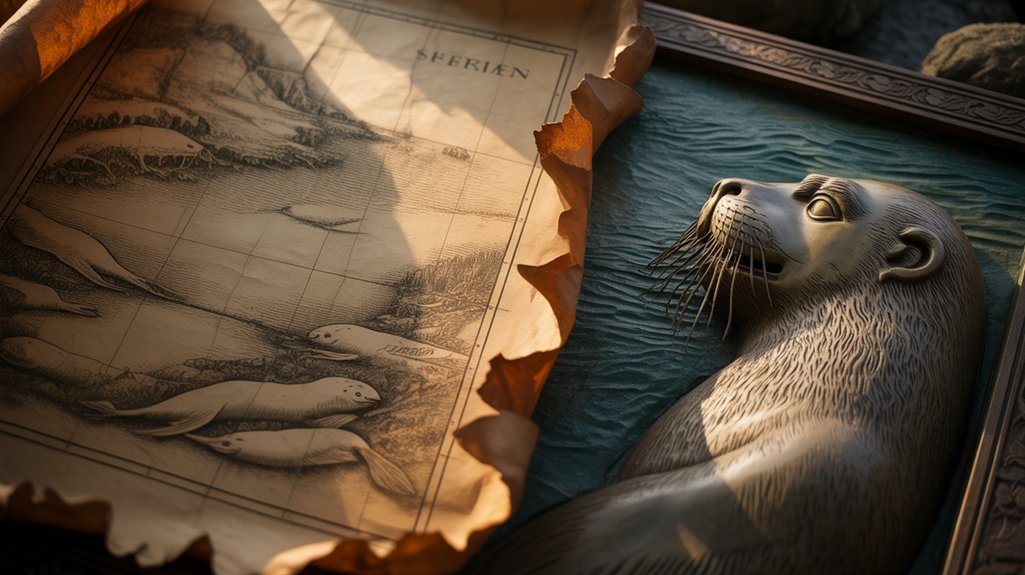
Unlike their female counterparts who suffer captivity and enforced domesticity, male selkies arrive on shore as agents of deliberate enchantment—storm-born seducers who shed their pelts beneath moonlight and seek out mortal women with calculated intent.
You'll find these seductive encounters follow distinct patterns across Scottish oral traditions, wherein married women, trapped in loveless unions, summon these chimeric beings through ritual—seven tears dropped into the tide at dawn. The mythic attraction operates as compensation, a primal answer to earthly disappointment.
| Summoning Method | Resulting Bond | Consequence |
|---|---|---|
| Seven tears at tide | Eldritch passion | Children born with webbed fingers |
| Moon-called ritual | Temporary union | Woman's perpetual longing |
| Accidental meeting | Forbidden desire | Husband's violent jealousy |
These encounters birth half-selkie offspring bearing aquatic markers—webbed digits, storm-grey eyes. The women who taste this otherworldly freedom never recover. They haunt coastlines thereafter, scanning horizons for seal-dark heads breaking surf, forever changed by what mortal marriage cannot provide.
The Seven Tears: Rituals for Summoning Selkie Lovers
Though scattered across various Hebridean testimonies and Orkney fishwife accounts from the 17th through 19th centuries, the ritual's core elements remain remarkably consistent: seven tears, saltwater convergence, and dawn's threshold moment.
You'll find the ritual significance extends beyond mere summoning—it represents your willingness to meet eldritch otherness halfway, to dissolve the boundaries that civilization imposes.
The practice demands:
- Seven tears shed into tidepool waters at the liminal hour between darkness and light
- A physical token offered freely—hair, blood, or something personally cherished
- Speaking your deepest longing aloud to the waves, naming what you truly seek
This wasn't desperation. It was emotional healing through deliberate communion with chimeric forces beyond human constraint.
The women who performed these rites understood: freedom requires vulnerability. They sought lovers unbound by land-based conventions, relationships existing outside patriarchal contracts.
The selkie answered those brave enough to weep openly, to surrender control.
Famous Selkie Ballads and Songs of the Scottish Isles
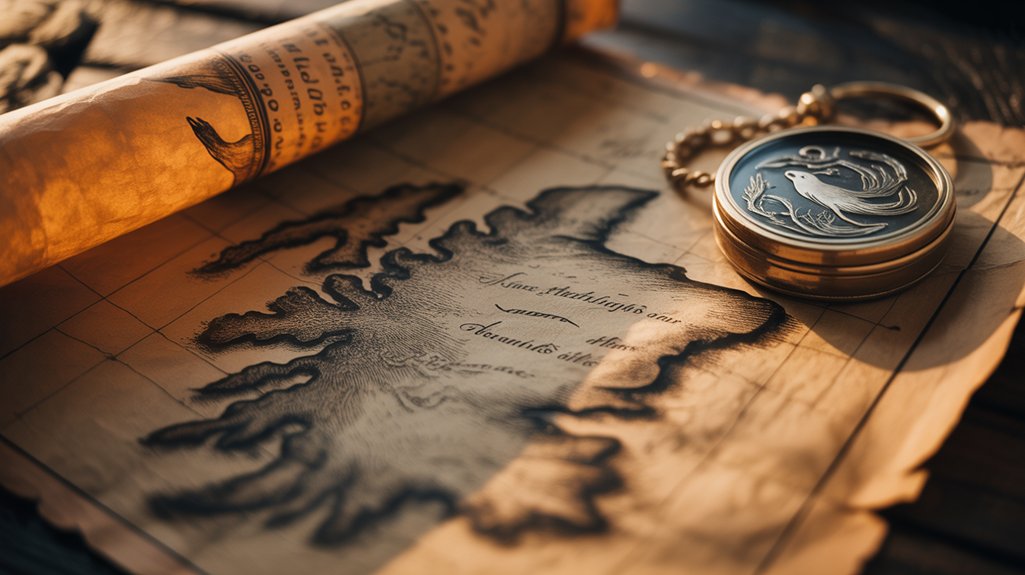
How did Scotland's coastal communities preserve their most haunting selkie encounters? Through ballads—ancient, eldritch verses that carried selkie symbolism across generations.
“The Great Silkie of Sule Skerry,” composed circa 1700s, remains the most chimeric example, recounting a seal-man's prophetic visit to his human lover. You'll find its modal melody haunting Orkney's windswept shores still.
These songs weren't mere entertainment. They were repositories of coastal wisdom, warnings against the sea's seductive pull.
“An Selchie's Lament” from the Hebrides, documented in 1859, captures the emotional resonance of stolen sealskins—that visceral ache of forced metamorphosis.
The Shetlandic “Hrossey's Bride” chronicles a fisher's daughter who discovered webbing between her fingers, salt-hunger consuming her thoughts. Each ballad preserves specific geographic origins: Orkney's tragic romances, the Hebrides' shape-shifting mysteries, Shetland's darker possessions.
You're not just hearing folk music. You're accessing liminal knowledge, encoded in minor keys and maritime metaphors.
Longing and Belonging: What Selkie Stories Reveal About Human Nature
Beneath the cadences of these ancient ballads lies a psychological architecture—the selkie myth functions as humanity's mirror for examining displacement, captivity, and the irreconcilable split between duty and desire.
You'll recognize yourself in these eldritch narratives. They speak to your own identity exploration, that chimeric journey between what you're and what circumstances demand you become.
The selkie's perpetual longing reveals:
- Captivity disguised as love—hidden sealskins symbolize stolen autonomy, domestic bonds becoming gilded cages
- The impossibility of dual belonging—neither fully seal nor human, the selkie embodies your fractured self when society demands conformity
- Primal emotional connections that transcend form—the selkie's oceanic calling persists despite terrestrial attachments
These Scottish tales, transmitted through generations since medieval times, don't merely entertain. They expose how captivity corrodes the spirit, how belonging somewhere doesn't guarantee being yourself.
The seal-folk's alteration isn't fantasy—it's your metamorphosis under constraint, your suppressed wildness, your remembering what freedom tastes like. Like other mythical creatures in Celtic scripture, selkies carry symbolism that extends far beyond their narrative origins, revealing fundamental truths about transformation and the human condition.
Modern Retellings: Selkies in Contemporary Literature and Film
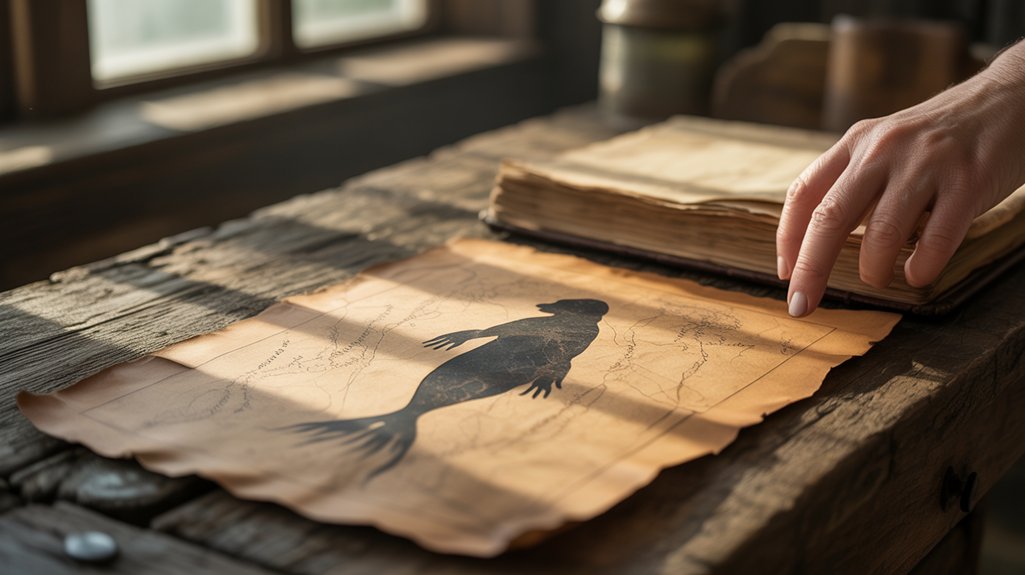
While the medieval ballads whispered their truths through centuries of oral tradition, contemporary artists have seized the selkie narrative with fierce urgency, changing these Celtic metamorphs into vessels for examining displacement, environmental collapse, and bodily autonomy.
Contemporary artists weaponize selkie myths as urgent vessels for bodily autonomy, displacement, and environmental catastrophe.
You'll find selkie symbolism threading through works like Margo Lanagan's “The Brides of Rollrock Island” (2012), where coerced alteration becomes a meditation on trafficking and consent.
Modern adaptations colonize multiple media—from films such as “Song of the Sea” (2014), where Saoirse embodies Ireland's eldritch heritage, to Andrea Stewart's “The Bone Shard Daughter,” which converts seal-folk into chimeric political metaphors.
These retellings rarely soften the original violence. Instead, they amplify it, weaponizing ancient longing against contemporary extraction economies.
The stolen sealskin becomes microplastics choking coastal waters. The captive selkie changes into every displaced indigenous population watching their homeland dissolve.
You're witnessing metamorphosis itself—old myths shedding archaic skins, emerging renewed for audiences demanding liberation narratives.
Frequently Asked Questions
Are Selkies Real or Have There Been Documented Seal-Human Hybrids?
You'll find no biological seal-human hybrids in documented science—selkie origins emerge purely from Celtic hybrid folklore, born from Scotland's mist-shrouded coastlines where seals' haunting, almost-human eyes sparked ancient imaginations.
These creatures exist as cultural truth, not zoological fact: eldritch beings dwelling in the liminal space between sea and shore, animal and human.
The selkie tradition represents your ancestors' attempt to explain the inexplicable, to name the wild freedom they witnessed in seal colonies altering coastal rocks into breathing, watching presences.
What Happens if a Selkie's Skin Is Destroyed or Burned?
Should you seek selkie skin destruction, selkie myths reveal a stark, sorrowful fate: eternal earthbound imprisonment.
When the precious pelt perishes—whether through fire, decay, or deliberate desecration—the selkie's chimeric essence shatters irreparably.
They're forever severed from oceanic origins, condemned to terrestrial existence without hope of returning home.
This eldritch change isn't merely physical but spiritual, as the destroyed skin represents an irreversible severance from their seal-soul.
The selkie becomes wholly human, trapped in landlocked grief, their marine evolution lost eternally.
Can Selkies Transform Into Other Animals Besides Seals?
You'll find that selkie changes remain bound exclusively to their dual nature—human and seal alone.
Unlike other Celtic shapeshifters who possess chimeric abilities, selkies don't engage in broader animal shapeshifting. Their metamorphosis, documented in Orcadian manuscripts since the 1400s, represents a fixed covenant between terrestrial and marine domains.
This singular change embodies their tragic beauty: freedom exists only within prescribed boundaries, neither fully wild nor completely human, forever oscillating between two immutable states.
Do Other Cultures Besides Scottish Have Similar Shapeshifting Seal Legends?
Like threads woven through ancient tapestries, you'll discover seal-shapeshifter legends across vast oceanic cultures.
Norse mythology preserved selkie-adjacent traditions throughout Scandinavia's fjord-carved coasts. Inuit legends speak of sedna's children—seals holding eldritch connections to humanity's soul.
Celtic folklore extends beyond Scotland into Ireland's windswept shores, where roane walk between worlds. Native tales from Pacific Northwestern tribes honor seal-people as sacred kin, their alterations marking liminal boundaries between terrestrial existence and oceanic mystery, freedom embodied through metamorphosis itself.
How Long Can a Selkie Stay on Land Without Their Skin?
You'll find no fixed selkie lifespan limit for land-dwelling in the ancient lore—the selkie skin doesn't impose temporal boundaries.
Rather, captivity itself becomes the constraint. Without their sealskin, selkies exist indefinitely on shore, trapped in human form, their oceanic essence slowly dimming.
The tragedy lies not in biological limitation but in spiritual exile. They endure years, decades even, landlocked and yearning.
Freedom calls through salt-wind whispers, through moon-pulled tides, through the hidden pelt that holds their metamorphosis.
Conclusion
You stand now at the shoreline's edge, that liminal threshold where selkie mothers once gazed landward with ineffable longing. These tales—transmitted through seven centuries of Orcadian oral tradition—illuminate humanity's eternal dualism: our simultaneous yearning for rootedness and transcendence. The selkie's hidden pelt becomes your own concealed authenticity, that essential self you've buried for belonging's sake. Perhaps you've already felt the sea's eldritch call, recognizing in these chimeric beings your own impossible desires for metamorphosis.
